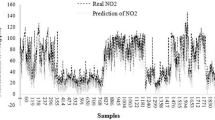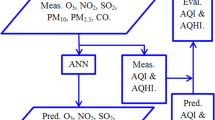Abstract
Air pollution was predicted in this study by using multiple linear regression and 42 different artificial neural network models in Iğdır/Turkey. Daily air quality data for the years 2016–2018 have been used in the modeling. In the prediction of the particulate matter which has 10 μm or less in diameter (PM10) concentration, sulfur dioxide, nitrogen oxides, nitrogen monoxide, ozone, nitrogen dioxide, relative humidity, air pressure, wind direction and wind speed data were used as input parameters. In the artificial neural network structures, two different learning functions, three different transfer functions and seven different neuron numbers were examined in the MATLAB software. According to results, multiple linear regression did not predict the PM10 concentration in the atmosphere. The R2 value was determined as 0.543 for the multiple linear regression. In this model, the RMSE, MAE and R2 were determined as 0.0488, 0.0248 and 0.9826, respectively. Since the R2 value in this model was quite high, it was concluded that the model is suitable for the prediction of PM10 concentration.





Similar content being viewed by others
References
Bai Y, Li Y, Xiaoxue W, Jingjing X, Chuan L (2016) Air pollutants concentrations forecasting using back propagation neural network based on wavelet decomposition with meteorological conditions. Atmos Pollut Res 7(3):557–566
Banja M, Papanastasiou DK, Poupkou A, Melas D (2012) Development of a short-term ozone prediction tool in Tirana area based on meteorological variables. Atmos Pollut Res 3:32–38
Bhanarkar AD, Goyal SK, Sivacoumar R, Rao CC (2005) Assessment of contribution of SO2 and NO2 from different sources in Jamshedpur region, India. Atmos Environ 39:7745–7760
Blanes-Vidal V, Cantuaria ML, Nadimi ES (2017) A novel approach for exposure assessment in air pollution epidemiological studies using neuro-fuzzy inference systems: comparison of exposure estimates and exposure-health associations. Environ Res 154:196–203
Brunelli U, Piazza V, Pignato L, Sorbello F, Vitabile S (2007) Two-days ahead prediction of daily maximum concentrations of SO2, O3, PM10, NO2, CO in the urban area of Palermo Italy. Atmos Environ 41:2967–2995
Coleman JSM, Rogers JC (2007) A synoptic climatology of the central United States and associations with Pacific teleconnection pattern frequency. J Clim 20:3485–3497
D’Amato G, Cecchi L, D’Amato M, Liccardi G (2010) Urban air pollution and climate change as environmental risk factors of respiratory allergy: an update. J Investig Allergol Clin Immunol 20:95–102
Elangasinghe MA, Singhal N, Dirks KN, Salmond JA (2014) Development of an ANN-based air pollution forecasting system with explicit knowledge through sensitivity analysis. Atmos Pollut Res 5:696–708
Fang D, Wang J (2017) A novel application of artificial neural network for wind speed estimation. Int J Sustain Energy 36(5):415–429
Gardner MW, Dorling SR (1998) Artificial neural networks (the multilayer perceptron)—a review of applications in the atmospheric science. Atmos Environ 32:2627–2636
Grivas G, Chaloulakou A (2006) Artificial neural network models for prediction of PM10 hourly concentrations, in the Greater Area of Athens, Greece. Atmos Environ 40:1216–1229
Hooyberghs J, Mensink C, Dumont G, Fierens F, Brasseur O (2005) A neural network forecast for daily average PM10 concentrations in Belgium. Atmos Environ 39:3279–3289
Hsu CH, Cheng FY (2019) Synoptic weather patterns and associated air pollution in Taiwan. Aerosol Air Qual Res 19:1139–1151
Huebnerova Z, Michalek J (2014) Analysis of daily average PM10 predictions by generalized linear models in Brno, Czech Republic. Atmos Pollut Res 5:471–476
Ibarra-Berastegi G, Elias A, Barona A, Saenz J, Ezcurra A, Argandona JD (2008) From diagnosis to prognosis for forecasting air pollution using neural networks: air pollution monitoring in Bilbao. Environ Model Softw 23:622–637
Jiang N, Hay JE, Fisher GW (2005) Effects of meteorological conditions on concentrations of nitrogen oxides in Auckland. Weather Clim 24:15–34
Jun YS, Jeong CH, Sabaliauskas K, Leaitch WR, Evans GJ (2014) A year-long comparison of particle formation events at paired urban and rural locations. Atmos Pollut Res 5:447–454
Junninen H, Niska H, Tuppurainen K, Ruuskanen J, Kolehmainen M (2004) Methods for imputation of missing values in air quality data sets. Atmos Sci 38:2895–2907
Kamal MM, Jailani R, Shauri RLA (2006) Prediction of ambient air quality based on neural network technique. In: 4th student conference on research and development, Selangor, 27–28 June 2006, pp 115–119
Kidson JW (2000) An analysis of New Zealand synoptic types and their use in defining weather regimes. Int J Climatol 20:299–316
Kukkonen J, Partanen L, Karppinen A, Ruuskanen J, Junninen H, Kolehmainen M, Niska H, Dorling S, Chatterton T, Foxall R, Cawley G (2003) Extensive evaluation of neural network models for the prediction of NO2 and PM10 concentrations, compared with a deterministic modeling system and measurements in central Helsinki. Atmos Environ 37:4549–4550
Kurt A, Oktay AB (2010) Forecasting air pollutant indicator levels with geographic models 3 days in advance using neural networks. Expert Syst Appl 37:7986–7992
Kurt A, Gulbagci B, Karaca F, Alagha O (2008) An online air pollution forecasting system using neural networks. Environ Int 34:592–598
Lee SH, Sung YH, Lee HW (2008) Impact of regional trans-boundary ozone associated with complex terrain on urban air quality. Atmos Environ 42:7384–7396
Lejeusne C, Chevaldonne P, Pergent-Martini C, Boudouresque CF, Perez T (2010) Climate change effects on a miniature ocean: the highly diverse, highly impacted Mediterranean Sea. Trends Ecol Evol 25:250–260
Liang J, Feng C, Zeng G, Zhong M, Gao X, Li X, He X, Li X, Fang Y, Mo D (2017) Atmospheric deposition of mercury and cadmium impacts on topsoil in a typical coal mine city, Lianyuan, China. Chemosphere 189:198–205
Lumbreras J, Valdes M, Borge R, Rodriguez ME (2008) Assessment of vehicle emissions projections in Madrid (Spain) from 2004 to 2012 considering several control strategies. Transp Res Part A Policy Pract 42:646–658
Matlab (2015) Matlab user manual—statistics toolbox. MathWorks, Natic
Ngan F, Byun D (2011) Classification of weather patterns and associated trajectories of high-ozone episodes in the Houston–Galveston–Brazoria area during the 2005/06 TexAQS-II. J Appl Meteorol Climatol 50:485–499
Oprea M, Iliadis L (2011) An artificial intelligence-based environment quality analysis system. Eng Appl Neural Netw 363:499–508
Ordieres JB, Vergara EP, Capuz RS, Salazar RE (2005) Neural network prediction model for fine particulate matter (PM2.5) on the US-Mexico border in El Paso (Texas) and Ciudad Juarez (Chihuahua). Environ Model Softw 20:547–559
Paschalidou AK, Karakitsios S, Kleanthous S, Kassomenos PA (2011) Forecasting hourly PM10 concentration in Cyprus through artificial neural networks and multiple regression models: implications to local environmental management. Environ Sci Pollut Res 18:316–327
Perez P, Reyes J (2006) An integrated neural network model for PM10 forecasting. Atmos Environ 40:2845–2851
Prasad K, Amit KG, Pramila G (2016) Development of ANFIS models for air quality forecasting and input optimization for reducing the computational cost and time. Atmos Environ 128:246–262
Russo AC, Gouveia CLM, Trigo RM, Liberato MLR, DaCamara CC (2015a) The influence of circulation weather patterns at different spatial scales on drought variability in the Iberian Peninsula. Front Environ Sci 3:42–56
Russo A, Lind PG, Raichel F, Trigo R, Mendes M (2015b) Neural network forecast of daily pollution concentration using optimal meteorological data at synoptic and local scales. Atmos Pollut Res 6(3):540–549
Sousa SIV, Martins FG, Pereira MC, Alvim-Ferraz MCM, Ribeiro H, Oliveira M, Abreu I (2008) Influence of atmospheric ozone, PM10 and meteorological factors on the concentration of airborne pollen and fungal spores. Atmos Environ 42:7452–7464
Turias IJ, Gonzalez FJ, Martin ML, Galindo PL (2008) Prediction models of CO, SPM and SO2 concentrations in the Campo de Gibraltar Region, Spain: a multiple comparison strategy. Environ Monit Assess 143:131–146
Zafra C, Ángel Y, Torres E (2017) ARIMA analysis of the effect of land surface coverage on PM10 concentrations in a high-altitude megacity. Atmos Pollut Res 8(4):660–668
Zhang X, Wang Y, Niu T, Zhang X, Gong S, Zhang Y, Sun J (2012) Atmospheric aerosol compositions in China: spatial/temporal variability, chemical signature, regional haze distribution and comparisons with global aerosols. Atmos Chem Phys 12:779–799
Acknowledgements
The author is grateful to the Turkey Ministry of Environment and Urbanization/National Air Quality Monitoring Service for their data, which have helped to improve this paper.
Author information
Authors and Affiliations
Corresponding author
Ethics declarations
Conflict of interest
The author declares having no conflict of interest.
Additional information
Editorial responsibility: M. Abbaspour.
Rights and permissions
About this article
Cite this article
Altikat, A. Modeling air pollution levels in volcanic geological regional properties and microclimatic conditions. Int. J. Environ. Sci. Technol. 17, 2377–2384 (2020). https://doi.org/10.1007/s13762-020-02635-x
Received:
Revised:
Accepted:
Published:
Issue Date:
DOI: https://doi.org/10.1007/s13762-020-02635-x




